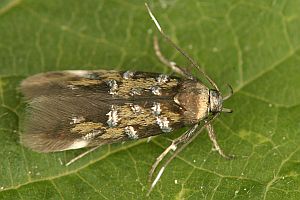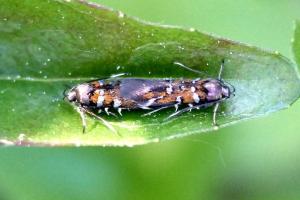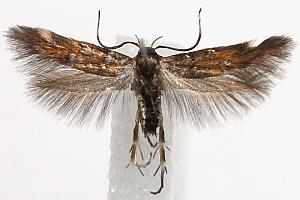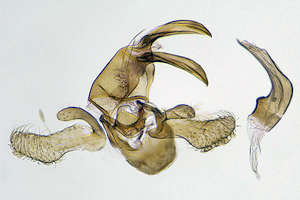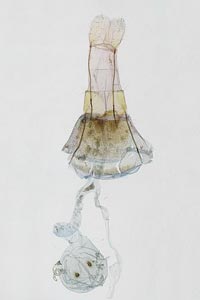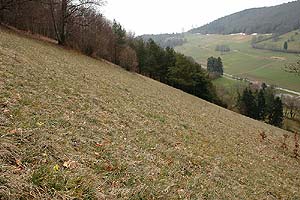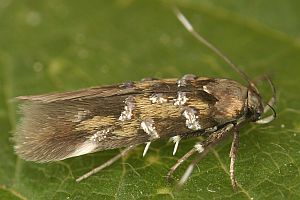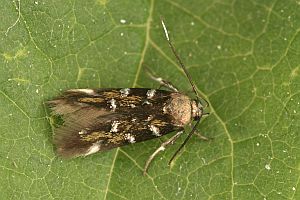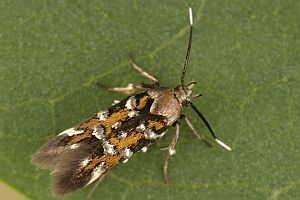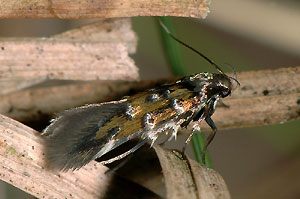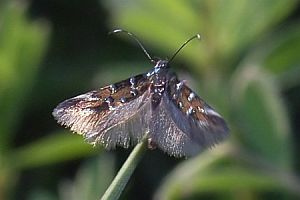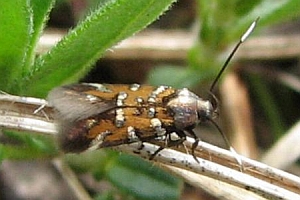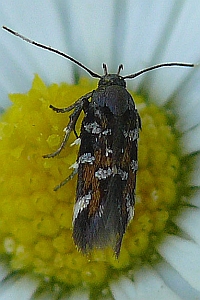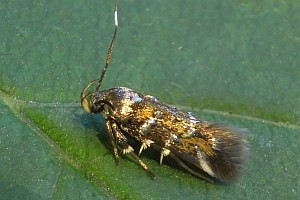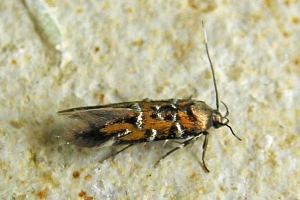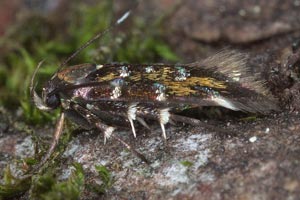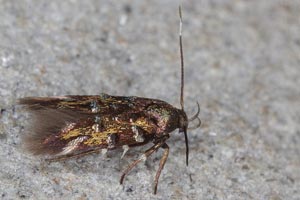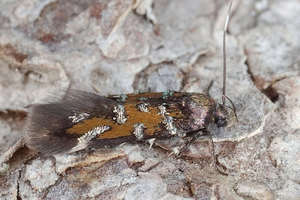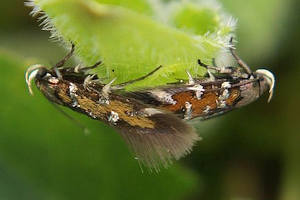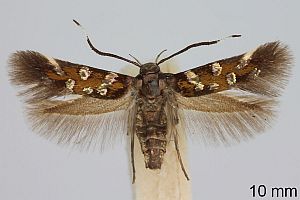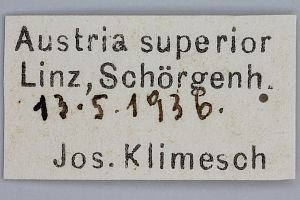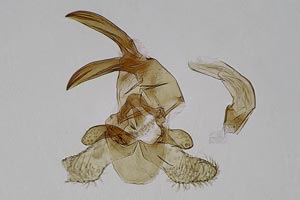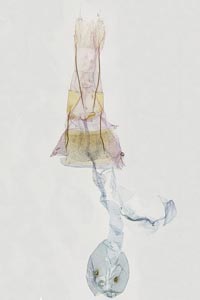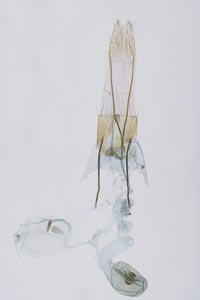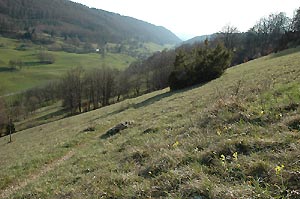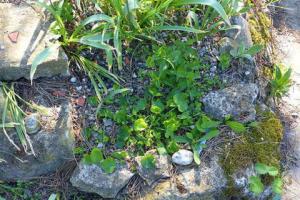

 +36Kontinente:EUAS
+36Kontinente:EUAS1. Lebendfotos
1.1. Falter
1.2. Kopula
2. Diagnose
2.1. Geschlecht nicht bestimmt
2.2. Genitalien
2.2.1. Männchen
2.2.2. Weibchen
2.3. Erstbeschreibung
3. Biologie
3.1. Habitat
3.2. Nahrung der Raupe
- [Violaceae:] Viola hirta (Rauhaariges Veilchen, Rauhhaariges Veilchen)
- [Violaceae:] Viola canina (Hunds-Veilchen)
- [Violaceae:] Viola tricolor [war hier das Acker-Stiefmütterchen, Viola arvensis gemeint ?]
Wie wir heute wissen leben (vermutlich alle) Pancalia-Arten an Veilchen. Doch es dauerte lange, bis das für die weit verbreitete P. leuwenhoekella geklärt war - und offensichtlich wird die Raupe auch heute kaum je gefunden. Weil es so schön erläutert, mit welchen Problemen unsere Altvorderen zu kämpfen hatten - und weil es so sehr daran erinnert, dass die Probleme mit den Zuchten damals auch nicht ganz unbekannt waren, vor allem aber, weil mir diese Schilderung einfach gefällt, möchte ich den Aufsatz "A contribution towards a life-history of Pancalia leuwenhoekella, L." von Fletcher (1893) fast vollständig wiedergeben. Ich bin gespannt auf Nachahmer, die uns hier schöne Bilder zur Geschichte liefern:
"Some years ago, probably in 1888, Mr. Warren, who had taken some specimens of Pancalia in the fen district, asked me in a letter if any species of Viola grew in the places in which I found P. Leuwenhoekella. It happened that I had noticed that wherever I found that insect some sort of violet grew, and that it had occurred to me that possibly the plant and moth were not unconnected. At the time Mr. Warren wrote I was inclined to think that the larva might feed on a species of Veronica. On receiving his letter, however, I planted some dog violets in a large pan, and in the latter part of May, 1889, imprisoned some female P. Leuwenhoekella among them. Towards the end of June some very small particles of " frass " seemed visible in the hearts of the plants. Early in July it was plain enough that there were larvae mining the petioles of the leaves and turning out frass through the small holes therein, as well as others depositing it in the centre of the plants.
A visit to the ancient British Camp, Cissbury, near Worthing, in the second week of the month, enabled me to find larvae feeding in the same way in a state of nature in Viola hirta, though too small to be worth collecting in any quantity. On the 27th of the month I went again to the locality, hoping to make a good haul of larvae ; the only result was about five or six larvae and harvest bugs ad lib. One of these larvae, just about to undergo its last moult, was in a short opaque gallery of silk and rubbish between the roots of its food-plant, and had eaten a large patch of bark from its underground stem. Some of the larvae captured earlier in the month and kept in a glass jar were then feeding in the same way.
The larvae are very difficult to find. The leaves of which the footstalk has been mined wither and drop from the plants, and so do many others seemingly damaged by sheep, rabbits, slugs, and other vermin, while the gnawing of the bark by the larvae does not cause the plants to flag.
The full-grown larva is about 10 mm. long when extended ; slender, tapering posteriorly; head pale yellowish-brown, mouth-parts marked with darker brown, top of lobes, median suture, and clypeus narrowly edged with the same shade; segmental divisions, wrinkles, and a broken longitudinal line of subdorsal indentations, strongly defined ; ground colour of body pale yellowish-brown, showing chiefly at the divisions and wrinkles, otherwise the dorsal surface is almost entirely of a dull purplish-red tint, paler towards both extremities and below the spiracles ; plate on 2nd segment very transparent, lobes of head showing plainly through it, with brown cloud on its outer edge ; flap clouded with brown, legs pale yellowish-brown; tubercles and bristles small and colourless ; ventral surface and claspers paler than the dorsal, tinged with pink.
The larvae, when removed from their galleries, crawl actively and twist about violently when irritated. They formed firm cocoons of silk and sawdust. Owing to the difficulty of keeping the food-plant fresh, but few pupae were obtained, so I did not venture to open the cocoons to examine them. Six moths emerged in the spring of 1890."
Koster & Sinev (2003) listen Viola hirta, V. canina und V. tricolor (war hier das Acker-Stiefmütterchen, Viola arvensis gemeint ?) auf.
Viola hirta ist durch die Arbeit von Fletcher (1893) als Freiland-Raupennahrung abgesichert; die Angabe zu Viola canina könnte rein auf der Zucht von Fletcher (1893) beruhen. Über "Viola tricolor" weiß ich nichts.
(Autor: Erwin Rennwald)
4. Weitere Informationen
4.1. Andere Kombinationen
- Phalaena (Tinea) leuwenhoekella Linnaeus, 1761 [Originalkombination]
4.2. Synonyme
- Oecophora schmidtella Treitschke, 1833
- Pancalia japonica Riedl, 1973
4.3. Unterarten
- Pancalia leuwenhoekella mandshuricella Sinev, 1985
4.4. Publikationsdatum der Erstbeschreibung
Argumentation für 1761 und Literaturangaben dazu: Siehe unter Acleris schalleriana.
4.5. Literatur
- Fletcher, W. H. B. (1893): A contribution towards a life-history of Pancalia leuwenhoekella, L. — The Entomologist's monthly Magazin 29: 81-82 [Biodiversity Heritage Library, Scan S. 81] [Biodiversity Heritage Library, Scan S. 82].
- Kayser, C. (2024): Ergänzungen zur Kleinschmetterlingsfauna Niedersachsens (2) (Microlepidoptera). — Melanargia 36 (3/4): 124-140.
- Koster, S. J. C. & S. Yu. Sinev (2003): Momphidae, Batrachedridae, Stathmopodidae, Agonoxenidae, Cosmopterigidae, Chrysopeleiidae. — In: Huemer, P., Karsholt, O. & L. Lyneborg [ed.]: Microlepidoptera of Europe 5: 1-387. Stenstrup (Apollo Books).
- Erstbeschreibung: Linnaeus, C. (1761): FAUNA SVECICA Sistens Animalia SVECIÆ Regni: MAMMALIA, AVES, AMPHIBIA, PISCES, INSECTA, VERMES. Distributa Per CLASSES & ORDINES, GENERA & SPECIES, Cum Differentiis Specierum, Synonymis Auctorum, Nominibus Incolarum, Locis Natalium, Descriptionibus Insectorum. Editio Altera, Auctior: Frontispiz, [i-xlviii], 1-578, pl. I-II. STOCKHOLMIÆ (LAURENTII SALVII).


































